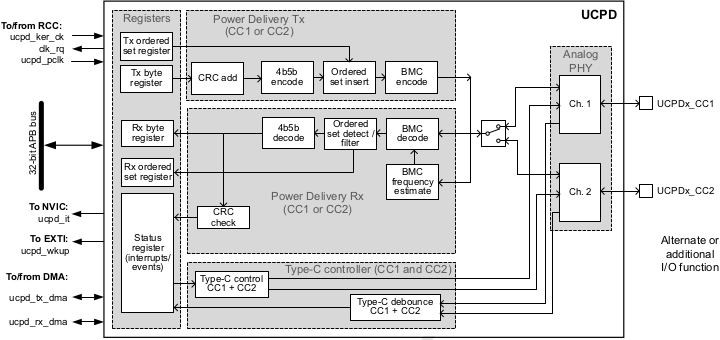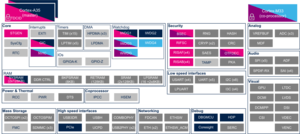1. Article purpose[edit | edit source]
The purpose of this article is to:
- briefly introduce the UCPD peripheral and its main features,
- indicate the peripheral instances assignment at boot time and their assignment at runtime (including whether instances can be allocated to secure contexts),
- list the software frameworks and drivers managing the peripheral,
- explain how to configure the peripheral.
2. Peripheral overview[edit | edit source]
The UCPD peripheral is used to support USB Type-C®/USB Power Delivery interface.
The built-in PHY directly detects Type-C voltage levels and covers the signaling of the USB Power Delivery specification on the CC lines.

The UCPD peripheral is compliant with:
Refer to the STM32 MPU reference manuals for the complete list of features, and to the software frameworks and drivers, introduced below, to see which features are implemented.
3. Peripheral usage[edit | edit source]
This chapter is applicable in the scope of the OpenSTLinux BSP running on the Arm® Cortex®-A processor(s), and the STM32CubeMPU Package running on the Arm® Cortex®-M processor.
3.1. Boot time assignment[edit | edit source]
3.1.1. On STM32MP2 series[edit | edit source]
Click on ![]() to expand or collapse the legend...
to expand or collapse the legend...
| Domain | Peripheral | Boot time allocation | Comment | |||
|---|---|---|---|---|---|---|
| Instance | Cortex-A35 secure (ROM code) |
Cortex-A35 secure (TF-A BL2) |
Cortex-A35 non-secure (U-Boot) | |||
| High speed interface | UCPD | UCPD1 | ⬚ | ⬚ | ||
3.2. Runtime assignment[edit | edit source]
3.2.1. On STM32MP25x lines  [edit | edit source]
[edit | edit source]
Click on ![]() to expand or collapse the legend...
to expand or collapse the legend...
| Domain | Peripheral | Runtime allocation | Comment | |||||
|---|---|---|---|---|---|---|---|---|
| Instance | Cortex-A35 secure (OP-TEE / TF-A BL31) |
Cortex-A35 non-secure (Linux) |
Cortex-M33 secure (TF-M) |
Cortex-M33 non-secure (STM32Cube) |
Cortex-M0+ (STM32Cube) | |||
| High speed interface | UCPD | UCPD1 | ⬚OP-TEE | ⬚ | ⬚ | ☐ | ||
4. Software frameworks and drivers[edit | edit source]
Below are listed the software frameworks and drivers managing the UCPD peripheral for the embedded software components listed in the above tables.
- STM32Cube: STM32_USBPD_Library
5. How to assign and configure the peripheral[edit | edit source]
The peripheral assignment can be done via the STM32CubeMX graphical tool (and manually completed if needed).
This tool also helps to configure the peripheral by generating:
- partial device trees (pin control and clock tree) for the OpenSTLinux software components,
- HAL initialization code for the STM32CubeMPU Package.
The configuration is applied by the firmware running in the context in which the peripheral is assigned.
- Linux®:
- Linux remoteproc framework allows to start the firmware running on the Arm® Cortex®-M33 (coprocessor).
This firmware configures and controls the UCPD internal peripheral. - Linux RPMsg framework allows the UCSI firmware to communicate with the STM32 UCSI Linux driver
- The link between the USB data controller and the Type-C connector can be configured through the Generic USB Connector Device Tree Bindings [3]. Examples to use the USB3DR internal peripheral can be found in USB3DR device tree configuration.
- Linux remoteproc framework allows to start the firmware running on the Arm® Cortex®-M33 (coprocessor).
6. How to go further[edit | edit source]
More information, tips, and tricks related to STM32 USB Type-C® Power Delivery, can be found in STM32 MCU wiki page:
X-CUBE-UCSI Expansion Package running on STM32MP135F-DK board, with STM32G0:
USBPD_DRP_UCSI Application running on STM32MP257x-EV1 board, in the Arm® Cortex®-M33 (coprocessor):
7. References[edit | edit source]
- ↑ USB Type-C specification release 2.2
- ↑ USB Power Delivery specifications revision 2.0 and 3.1
- ↑ Documentation/devicetree/bindings/connector/usb-connector.yaml , Generic USB Connector Device Tree Bindings
